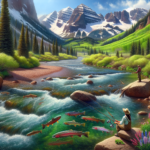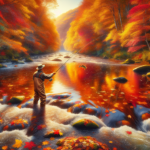Summer Walleye Fishing in the Great Lakes

Introduction
Did you know that the Great Lakes hold over 20% of the world’s fresh surface water and are home to some of the best walleye fishing spots in North America? Whether you’re a seasoned angler or a novice looking to catch your first walleye, summer fishing in the Great Lakes offers an unparalleled experience. This article will guide you through the essential techniques, best fishing spots, and necessary gear to make your summer walleye fishing trip a success.
In this comprehensive guide, we will cover the historical and geographical context of walleye fishing in the Great Lakes, delve into the best fishing techniques, provide detailed species information, and highlight top fishing locations. We’ll also discuss seasonal considerations, local events, and tournaments, and offer tips and best practices to enhance your fishing experience. Finally, we’ll provide gear recommendations, safety tips, and conservation practices to ensure a responsible and enjoyable fishing trip.
Understanding the intricacies of summer walleye fishing in the Great Lakes is crucial for maximizing your catch and enjoying a fulfilling outdoor adventure. Whether you’re looking to find the best fishing spots, master specific techniques, or prepare for a local tournament, this guide has you covered.
Background/Context
Historical or Cultural Significance
Walleye fishing has a rich history in the Great Lakes region, dating back to indigenous communities who relied on these fish as a staple food source. Over the years, walleye have become a prized catch for recreational anglers due to their elusive nature and delicious taste. The Great Lakes, particularly Lake Erie, have earned a reputation as premier walleye fishing destinations, attracting anglers from across the globe.
Geographical Overview
The Great Lakes consist of five interconnected freshwater lakes: Superior, Michigan, Huron, Erie, and Ontario. These lakes span over 94,000 square miles and are bordered by eight U.S. states and the Canadian province of Ontario. The region’s diverse climate, ranging from cold winters to warm summers, creates an ideal habitat for walleye. The lakes’ varied topography, including rocky shorelines, sandy beaches, and deep basins, provides numerous fishing opportunities.
Key Points/Details
Fishing Techniques
Technique Overview
Several techniques are effective for catching walleye in the Great Lakes during the summer months. These include trolling, jigging, and casting. Trolling involves dragging lures or bait behind a moving boat, covering large areas to locate schools of walleye. Jigging uses a weighted lure that is vertically moved to mimic prey, while casting involves throwing lures and retrieving them to attract fish.
When and Where to Use
Trolling is particularly effective in open waters and along drop-offs where walleye tend to congregate. Jigging works well in deeper waters and around structures like reefs and submerged vegetation. Casting is ideal for targeting walleye near shorelines, weed beds, and rocky areas. Early morning and late evening are prime times for walleye fishing, as these fish are more active during low-light conditions.
Recommended Gear
- Rods: Medium to medium-heavy action rods, around 6-7 feet in length.
- Reels: Spinning or baitcasting reels with a smooth drag system.
- Lines: Braided or monofilament lines, 8-12 lb test for trolling and casting, 10-20 lb test for jigging.
- Bait/Lures: Crankbaits, spinnerbaits, jigs, and live bait such as minnows or nightcrawlers.
Species Information
Species Overview
Walleye (Sander vitreus) are a predatory fish species known for their sharp teeth and excellent vision in low-light conditions. They prefer cooler waters and are often found in deeper parts of the lakes during the summer. Walleye are most active during dawn and dusk, making these times ideal for fishing.
Best Practices
To successfully catch walleye, use lures that mimic their natural prey, such as minnows and small fish. Pay attention to water temperature and depth, as walleye tend to move to cooler, deeper waters during the heat of the day. Experiment with different retrieval speeds and techniques to find what works best in the given conditions.
Location Information
Top Fishing Spots
- Lake Erie: Known for its abundant walleye population, particularly around the Western Basin and the islands.
- Lake Ontario: The Bay of Quinte is a renowned walleye hotspot.
- Lake Huron: Saginaw Bay offers excellent walleye fishing opportunities.
- Lake Michigan: Green Bay is a popular destination for walleye anglers.
- Lake Superior: The Apostle Islands region provides good walleye fishing.
Regulations and Licenses
Fishing regulations and license requirements vary by state and province. Anglers should check local regulations for specific rules on catch limits, size restrictions, and seasonal closures. Most states and provinces offer online resources for purchasing fishing licenses and reviewing regulations.
Seasonal Considerations
Seasonal Variations
Walleye behavior and fishing conditions change throughout the year. In summer, walleye move to deeper, cooler waters during the day and become more active in shallower areas during dawn and dusk. Anglers should adjust their techniques and gear accordingly to match these seasonal patterns.
Best Times to Fish
The best times to fish for walleye in the Great Lakes during summer are early morning (around sunrise) and late evening (around sunset). These low-light periods coincide with increased walleye activity, improving your chances of a successful catch.
Events and Tournaments
Event Overview
The Great Lakes region hosts several walleye fishing tournaments and events throughout the summer. Notable events include the Lake Erie Walleye Trail (LEWT) and the Bay of Quinte Walleye World Tournament. These events attract anglers of all skill levels and offer opportunities to compete for prizes and recognition.
Preparation Tips
- Gear: Ensure your gear is in top condition, with fresh lines, sharp hooks, and well-maintained reels.
- Practice: Spend time practicing your techniques and familiarizing yourself with the tournament rules.
- Strategy: Develop a game plan based on local fishing reports and conditions.
Tips and Best Practices
General Tips
- Use a fish finder to locate schools of walleye and identify underwater structures.
- Experiment with different lure colors and sizes to match the local forage.
- Pay attention to weather patterns, as walleye activity can be influenced by changes in barometric pressure.
Avoid Common Mistakes
- Avoid fishing in overly shallow waters during the heat of the day, as walleye tend to move deeper.
- Don’t neglect your gear maintenance; a poorly functioning reel or dull hook can cost you a catch.
- Be patient and persistent; walleye can be elusive, so it may take time to find the right spot and technique.
Advanced Techniques
- Use planer boards to spread your lines and cover more water while trolling.
- Try vertical jigging with soft plastics or blade baits in deeper waters.
- Utilize slip bobbers to present live bait at precise depths.
Gear and Equipment Recommendations
Essential Gear
- Medium to medium-heavy action rods (6-7 feet)
- Spinning or baitcasting reels with smooth drag systems
- Braided or monofilament lines (8-20 lb test)
- Crankbaits, spinnerbaits, jigs, and live bait
- Fish finder and GPS unit
Optional Gear/Upgrades
- Planer boards for trolling
- Slip bobbers for precise bait presentation
- Electric trolling motor for better boat control
- Underwater camera for scouting fishing spots
Where to Buy or Rent
Local bait and tackle shops around the Great Lakes region offer a wide range of fishing gear and equipment. Online retailers like Bass Pro Shops, Cabela’s, and Amazon also provide extensive selections. Some marinas and fishing lodges may offer gear rentals for those who prefer not to bring their own equipment.
Safety and Conservation
Safety Tips
- Always wear a life jacket when on the water.
- Check weather forecasts before heading out and be prepared for sudden changes.
- Inform someone of your fishing plans and expected return time.
- Carry a first aid kit and emergency supplies on your boat.
Conservation Practices
- Practice catch and release to help maintain healthy walleye populations.
- Follow local fishing regulations and respect size and bag limits.
- Avoid disturbing natural habitats and dispose of trash properly.
- Use barbless hooks to minimize injury to released fish.
Planning Your Trip
Accommodations
The Great Lakes region offers a variety of accommodations, from campgrounds and RV parks to hotels and fishing lodges. Popular options include state parks with camping facilities, waterfront resorts, and vacation rentals near prime fishing spots.
Travel Tips
- Plan your route in advance and check for any road closures or construction.
- Consider renting a boat if you don’t have your own, as many marinas offer rentals.
- Pack essential items such as sunscreen, insect repellent, and plenty of water.
Additional Activities
In addition to fishing, the Great Lakes region offers numerous recreational activities, including hiking, boating, swimming, and wildlife watching. Many areas also feature cultural attractions, such as museums, historic sites, and local festivals, making it an ideal destination for families and groups.
Frequently Asked Questions (FAQs)
What is the best time of day to fish for walleye in the Great Lakes during summer?
The best times to fish for walleye are early morning (around sunrise) and late evening (around sunset) when they are most active.
Do I need a fishing license to fish in the Great Lakes?
Yes, a fishing license is required to fish in the Great Lakes. License requirements vary by state and province, so check local regulations before your trip.
What type of bait is most effective for catching walleye?
Effective baits for walleye include live bait such as minnows and nightcrawlers, as well as artificial lures like crankbaits, spinnerbaits, and jigs.
Are there any fishing tournaments in the Great Lakes region?
Yes, the Great Lakes region hosts several walleye fishing tournaments, including the Lake Erie Walleye Trail (LEWT) and the Bay of Quinte Walleye World Tournament.
Conclusion
Summer walleye fishing in the Great Lakes offers an exciting and rewarding experience for anglers of all skill levels. By understanding the best techniques, gear, and locations, you can maximize your chances of a successful catch. Remember to follow safety guidelines and conservation practices to ensure a responsible and enjoyable fishing trip. Whether you’re targeting walleye in Lake Erie, Lake Ontario, or any of the other Great Lakes, this guide provides the essential information you need to plan and execute a memorable fishing adventure.
So grab your gear, head to the Great Lakes, and get ready to reel in some impressive walleye this summer!




